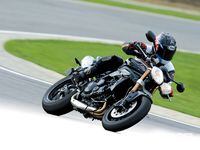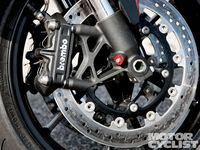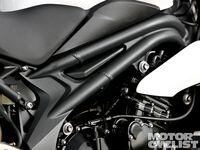Making a great bike better is no easy task, so have sympathy for the blokes charged with developing a new version of Triumph's iconic Speed Triple. The original stripped-down streetfighter was unveiled in 1994, and its rugged good looks and intoxicating engine have won it numerous shootouts and helped it sell over 65,000 examples in the 16 years since. So how do you make the king of naked bikes better? For the most part, you just try not to muck it up!
Even before riding the end result of a revision three years in the making, the most controversial aspect of the redesign was apparent the moment the cover was whipped off at the Intermot show in Germany last fall. Gone are the distinctive round headlamps with chrome bezels, replaced by less retro but still separate pentagonal units. The only other immediately apparent aesthetic change is the addition of cowlings above the radiator, which give the new bike a more finished look.
The chance to ride the 2011 Speed Triple came shortly afterward at the Ascari Race Resort in southern Spain. As soon as you sling a leg over the bike, you realize it's quite different. The riding position is significantly revised, with a reshaped tank moving the rider 1.75 inches closer to the bars, which have been shifted back slightly. The frame is narrower at the waist and the footpegs closer together and further forward, making the bike feel slimmer and more upright while also making it easier to put your feet flat on the ground. The frame is all-new, and cants the big three-cylinder engine forward and slightly closer to the front wheel. Geometry changes include a steeper steering head angle, increased trail and a longer swingarm for a longer wheelbase. Both the ergonomic and geometric changes were enacted to achieve a revised weight balance for better comfort, handling and stability.
The end result is a bike with considerably improved steering and more nimble handling, with excellent turn-in on the brakes-a little too good, to begin with, until the technicians added some preload and compression to the Showa fork. That delivered more controlled turn-in without sacrificing agility, allowing me to take full advantage of the much improved front-brake package which uses a Brembo master cylinder that offers better modulation than the previous Nissin unit.
I'll admit to being a little surprised to find the new Speed Triple doesn't have a slipper clutch, as practically all big-bore bikes do nowadays. But my repeated efforts to invoke rear-wheel chatter came up short. The Triumph engineers say they designed the bike that way, utilizing the idle-control motor to keep engine braking from breaking rear-wheel traction. That makes this the streetbike equivalent of the variable idle-speed systems featured on MotoGP and World Superbike racers, and saves Triumph the extra expense and weight penalty of fitting a slipper clutch.
Saving weight was a key issue in developing the new bike-especially unsprung weight. Despite a wider 6-inch rear rim and bigger 190mm rear tire, the wheels account for the majority of the bike's 6-lb. weight reduction. That savings is due in part to less metal but also due to lighter Metzeler Racetec Interact tires.
Not only is the bike lighter, it's stronger, too. Instead of overhauling the engine, Triumph chose to refine it by reducing internal pumping losses, increasing air-filter area and tweaking the fuel injection. The motor is Euro 3-compliant thanks to a repositioned single catalyst that's tucked in under the motor rather than in the transfer pipe before each muffler as before. Moving the catalyzer closer to the exhaust ports let the engineers reduce its density in favor of performance and weight reduction.
This refined powerplant delivers a claimed 133 horsepower at 9400 rpm. That's 5 bhp more than before, but there's a huge 8 percent increase in maximum torque to 82 lb.-ft. at 7750 rpm. This handily addresses the loss in midrange punch occasioned four years ago in meeting Euro 3 requirements, and makes the Speed Triple even more fun to ride. It pulls hard off idle, takes full-throttle inputs from just 2000 rpm and runs without a glitch all the way to the 10,500-rpm rev limiter. Of course, with such a wide spread of power there's no need to rev it that high, unless you feel the need to showboat for the owner of some other manufacturer's street brawler. The only other reason you might feel the need to spin the Triumph to the top is to hear the muted howl from that fantastic three-cylinder engine. After short-shifting up through the six-speed gearbox, you'll find yourself blipping the throttle emphatically as you downshift just to be sure of a full concerto performance. This bike is a joy to ride in both dynamic and musical terms!
The 2011 Speed Triple is indeed more refined than its predecessor, whose elemental rawness has been smoothed away somewhat-not only by sacrificing its goggle-eyed, stripped-back styling, but in the whole riding experience it offers. The new bike is a better-rounded package that is easier and more comfortable to ride-and to go fast on. But don't worry, this doesn't mean the streetfighter that started it all is growing old. It's just growing up-and it's a better ride as a result.
Tech Spec
Evolution
The Speed Triple receives an all-new frame, revised ergonomics, a gently massaged engine and polarizing headlights.
Rivals
Aprilia Tuono, Ducati Streetfighter, KTM Super Duke, Moto Guzzi Griso, MV Agusta Brutale.
Contact
Triumph Motorcycles of America, Ltd.
385 Walt Sanders Memorial Dr. #100
Newnan, GA 30265
678.854.2010
www.triumphmotorcycles.com
Verdict 4.5 out of 5 stars
Besides those bizarre headlights, the new Speed Triple is a better bike in all respects.















/cloudfront-us-east-1.images.arcpublishing.com/octane/GTCXACQGJ5HAPDTGWUQKDEH44E.jpg)
/cloudfront-us-east-1.images.arcpublishing.com/octane/S35YGSEMEZB4BLTDJTSZPF4GLA.jpg)
/cloudfront-us-east-1.images.arcpublishing.com/octane/5UOT6HPX2JFMRJAX6EH45AR4MQ.jpg)
/cloudfront-us-east-1.images.arcpublishing.com/octane/OKWOJWAKP5EP3OACCRRWPCIX2Q.jpg)
/cloudfront-us-east-1.images.arcpublishing.com/octane/2WF3SCE3NFBQXLDNJM7KMXA45E.jpg)
/cloudfront-us-east-1.images.arcpublishing.com/octane/G4MG6OUCJNBSHIS2MVVOTPX65E.jpg)
/cloudfront-us-east-1.images.arcpublishing.com/octane/IIGGWFOTOJGB7DB6DGBXCCMTDY.jpg)
/cloudfront-us-east-1.images.arcpublishing.com/octane/QSTCM6AVEZA5JJBUXNIQ3DSOF4.jpg)
/cloudfront-us-east-1.images.arcpublishing.com/octane/U4I7G625B5DMLF2DVIJDFZVV6M.jpg)
/cloudfront-us-east-1.images.arcpublishing.com/octane/B6XD6LS6IVCQPIU6HXDJSM3FHY.jpg)
/cloudfront-us-east-1.images.arcpublishing.com/octane/ICL63FEDDRDTTMINYICCEYGMDA.jpg)
/cloudfront-us-east-1.images.arcpublishing.com/octane/FCGZHQXRBZFLBAPC5SDIQLVF4I.jpg)
/cloudfront-us-east-1.images.arcpublishing.com/octane/WNOB6LDOIFFHJKPSVIWDYUGOPM.jpg)

/cloudfront-us-east-1.images.arcpublishing.com/octane/X33NU3E525ECRHXLNUJN2FTRKI.jpg)
/cloudfront-us-east-1.images.arcpublishing.com/octane/6KKT5NNL2JAVBOXMZYS5ZO76YA.jpg)
/cloudfront-us-east-1.images.arcpublishing.com/octane/J5RKG5O455GMPGQRF2OG6LRT7A.jpg)
/cloudfront-us-east-1.images.arcpublishing.com/octane/GX2CIZKQVRH2TATDM26KFG2DAE.jpg)
/cloudfront-us-east-1.images.arcpublishing.com/octane/ZWIDYSAKQZHD5BHREMQILXJCGM.jpg)
/cloudfront-us-east-1.images.arcpublishing.com/octane/CYUHJZCTSJCH3MRAQEIKXK7SCQ.jpg)
/cloudfront-us-east-1.images.arcpublishing.com/octane/LKOFINY56FCXJCANJ5M7ZDQUBY.jpg)
/cloudfront-us-east-1.images.arcpublishing.com/octane/4NBPDACMWJH63JQYJVK3QRBDZI.jpg)
/cloudfront-us-east-1.images.arcpublishing.com/octane/KKHQHRR3FJGX7H2IPU6RALMWG4.jpg)
